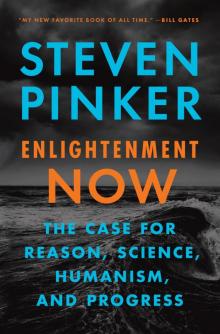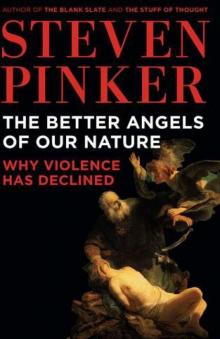- Home
- Steven Pinker
Enlightenment Now Page 6
Enlightenment Now Read online
Page 6
Epithets aside, the idea that the world is better than it was and can get better still fell out of fashion among the clerisy long ago. In The Idea of Decline in Western History, Arthur Herman shows that prophets of doom are the all-stars of the liberal arts curriculum, including Nietzsche, Arthur Schopenhauer, Martin Heidegger, Theodor Adorno, Walter Benjamin, Herbert Marcuse, Jean-Paul Sartre, Frantz Fanon, Michel Foucault, Edward Said, Cornel West, and a chorus of eco-pessimists.1 Surveying the intellectual landscape at the end of the 20th century, Herman lamented a “grand recessional” of “the luminous exponents” of Enlightenment humanism, the ones who believed that “since people generate conflicts and problems in society, they can also resolve them.” In History of the Idea of Progress, the sociologist Robert Nisbet agreed: “The skepticism regarding Western progress that was once confined to a very small number of intellectuals in the nineteenth century has grown and spread to not merely the large majority of intellectuals in this final quarter of the century, but to many millions of other people in the West.”2
Yes, it’s not just those who intellectualize for a living who think the world is going to hell in a handcart. It’s ordinary people when they switch into intellectualizing mode. Psychologists have long known that people tend to see their own lives through rose-colored glasses: they think they’re less likely than the average person to become the victim of a divorce, layoff, accident, illness, or crime. But change the question from the people’s lives to their society, and they transform from Pollyanna to Eeyore.
Public opinion researchers call it the Optimism Gap.3 For more than two decades, through good times and bad, when Europeans were asked by pollsters whether their own economic situation would get better or worse in the coming year, more of them said it would get better, but when they were asked about their country’s economic situation, more of them said it would get worse.4 A large majority of Britons think that immigration, teen pregnancy, litter, unemployment, crime, vandalism, and drugs are a problem in the United Kingdom as a whole, while few think they are problems in their area.5 Environmental quality, too, is judged in most nations to be worse in the nation than in the community, and worse in the world than in the nation.6 In almost every year from 1992 through 2015, an era in which the rate of violent crime plummeted, a majority of Americans told pollsters that crime was rising.7 In late 2015, large majorities in eleven developed countries said that “the world is getting worse,” and in most of the last forty years a solid majority of Americans have said that the country is “heading in the wrong direction.”8
Are they right? Is pessimism correct? Could the state of the world, like the stripes on a barbershop pole, keep sinking lower and lower? It’s easy to see why people feel that way: every day the news is filled with stories about war, terrorism, crime, pollution, inequality, drug abuse, and oppression. And it’s not just the headlines we’re talking about; it’s the op-eds and long-form stories as well. Magazine covers warn us of coming anarchies, plagues, epidemics, collapses, and so many “crises” (farm, health, retirement, welfare, energy, deficit) that copywriters have had to escalate to the redundant “serious crisis.”
Whether or not the world really is getting worse, the nature of news will interact with the nature of cognition to make us think that it is. News is about things that happen, not things that don’t happen. We never see a journalist saying to the camera, “I’m reporting live from a country where a war has not broken out”—or a city that has not been bombed, or a school that has not been shot up. As long as bad things have not vanished from the face of the earth, there will always be enough incidents to fill the news, especially when billions of smartphones turn most of the world’s population into crime reporters and war correspondents.
And among the things that do happen, the positive and negative ones unfold on different time lines. The news, far from being a “first draft of history,” is closer to play-by-play sports commentary. It focuses on discrete events, generally those that took place since the last edition (in earlier times, the day before; now, seconds before).9 Bad things can happen quickly, but good things aren’t built in a day, and as they unfold, they will be out of sync with the news cycle. The peace researcher John Galtung pointed out that if a newspaper came out once every fifty years, it would not report half a century of celebrity gossip and political scandals. It would report momentous global changes such as the increase in life expectancy.10
The nature of news is likely to distort people’s view of the world because of a mental bug that the psychologists Amos Tversky and Daniel Kahneman called the Availability heuristic: people estimate the probability of an event or the frequency of a kind of thing by the ease with which instances come to mind.11 In many walks of life this is a serviceable rule of thumb. Frequent events leave stronger memory traces, so stronger memories generally indicate more-frequent events: you really are on solid ground in guessing that pigeons are more common in cities than orioles, even though you’re drawing on your memory of encountering them rather than on a bird census. But whenever a memory turns up high in the result list of the mind’s search engine for reasons other than frequency—because it is recent, vivid, gory, distinctive, or upsetting—people will overestimate how likely it is in the world. Which are more numerous in the English language, words that begin with k or words with k in the third position? Most people say the former. In fact, there are three times as many words with k in the third position (ankle, ask, awkward, bake, cake, make, take . . .), but we retrieve words by their initial sounds, so keep, kind, kill, kid, and king are likelier to pop into mind on demand.
Availability errors are a common source of folly in human reasoning. First-year medical students interpret every rash as a symptom of an exotic disease, and vacationers stay out of the water after they have read about a shark attack or if they have just seen Jaws.12 Plane crashes always make the news, but car crashes, which kill far more people, almost never do. Not surprisingly, many people have a fear of flying, but almost no one has a fear of driving. People rank tornadoes (which kill about fifty Americans a year) as a more common cause of death than asthma (which kills more than four thousand Americans a year), presumably because tornadoes make for better television.
It’s easy to see how the Availability heuristic, stoked by the news policy “If it bleeds, it leads,” could induce a sense of gloom about the state of the world. Media scholars who tally news stories of different kinds, or present editors with a menu of possible stories and see which they pick and how they display them, have confirmed that the gatekeepers prefer negative to positive coverage, holding the events constant.13 That in turn provides an easy formula for pessimists on the editorial page: make a list of all the worst things that are happening anywhere on the planet that week, and you have an impressive-sounding case that civilization has never faced greater peril.
The consequences of negative news are themselves negative. Far from being better informed, heavy newswatchers can become miscalibrated. They worry more about crime, even when rates are falling, and sometimes they part company with reality altogether: a 2016 poll found that a large majority of Americans follow news about ISIS closely, and 77 percent agreed that “Islamic militants operating in Syria and Iraq pose a serious threat to the existence or survival of the United States,” a belief that is nothing short of delusional.14 Consumers of negative news, not surprisingly, become glum: a recent literature review cited “misperception of risk, anxiety, lower mood levels, learned helplessness, contempt and hostility towards others, desensitization, and in some cases, . . . complete avoidance of the news.”15 And they become fatalistic, saying things like “Why should I vote? It’s not gonna help,” or “I could donate money, but there’s just gonna be another kid who’s starving next week.”16
Seeing how journalistic habits and cognitive biases bring out the worst in each other, how can we soundly appraise the state of the world? The answer is to count. How many people are victims of violence as a proportion of
the number of people alive? How many are sick, how many starving, how many poor, how many oppressed, how many illiterate, how many unhappy? And are those numbers going up or down? A quantitative mindset, despite its nerdy aura, is in fact the morally enlightened one, because it treats every human life as having equal value rather than privileging the people who are closest to us or most photogenic. And it holds out the hope that we might identify the causes of suffering and thereby know which measures are most likely to reduce it.
That was the goal of my 2011 book The Better Angels of Our Nature, which presented a hundred graphs and maps showing how violence and the conditions that foster it have declined over the course of history. To emphasize that the declines took place at different times and had different causes, I gave them names. The Pacification Process was a fivefold reduction in the rate of death from tribal raiding and feuding, the consequence of effective states exerting control over a territory. The Civilizing Process was a fortyfold reduction in homicide and other violent crimes which followed upon the entrenchment of the rule of law and norms of self-control in early modern Europe. The Humanitarian Revolution is another name for the Enlightenment-era abolition of slavery, religious persecution, and cruel punishments. The Long Peace is the historians’ term for the decline of great-power and interstate war after World War II. Following the end of the Cold War, the world has enjoyed a New Peace with fewer civil wars, genocides, and autocracies. And since the 1950s the world has been swept by a cascade of Rights Revolutions: civil rights, women’s rights, gay rights, children’s rights, and animal rights.
Few of these declines are contested among experts who are familiar with the numbers. Historical criminologists, for example, agree that homicide plummeted after the Middle Ages, and it’s a commonplace among international-relations scholars that major wars tapered off after 1945. But they come as a surprise to most people in the wider world.17
I had thought that a parade of graphs with time on the horizontal axis, body counts or other measures of violence on the vertical, and a line that meandered from the top left to the bottom right would cure audiences of the Availability bias and persuade them that at least in this sphere of well-being the world has made progress. But I learned from their questions and objections that resistance to the idea of progress runs deeper than statistical fallacies. Of course, any dataset is an imperfect reflection of reality, so it is legitimate to question how accurate and representative the numbers truly are. But the objections revealed not just a skepticism about the data but also an unpreparedness for the possibility that the human condition has improved. Many people lack the conceptual tools to ascertain whether progress has taken place or not; the very idea that things can get better just doesn’t compute. Here are stylized versions of dialogues I have often had with questioners.
So violence has declined linearly since the beginning of history! Awesome!
No, not “linearly”—it would be astonishing if any measure of human behavior with all its vicissitudes ticked downward by a constant amount per unit of time, decade after decade and century after century. And not monotonically, either (which is probably what the questioners have in mind)—that would mean that it always decreased or stayed the same, never increased. Real historical curves have wiggles, upticks, spikes, and sometimes sickening lurches. Examples include the two world wars, a boom in crime in Western countries from the mid-1960s to the early 1990s, and a bulge of civil wars in the developing world following decolonization in the 1960s and 1970s. Progress consists of trends in violence on which these fluctuations are superimposed—a downward swoop or drift, a return from a temporary swelling to a low baseline. Progress cannot always be monotonic because solutions to problems create new problems.18 But progress can resume when the new problems are solved in their turn.
By the way, the nonmonotonicity of social data provides an easy formula for news outlets to accentuate the negative. If you ignore all the years in which an indicator of some problem declines, and report every uptick (since, after all, it’s “news”), readers will come away with the impression that life is getting worse and worse even as it gets better and better. In the first six months of 2016 the New York Times pulled this trick three times, with figures for suicide, longevity, and automobile fatalities.
Well, if levels of violence don’t always go down, that means they’re cyclical, so even if they’re low right now it’s only a matter of time before they go back up.
No, changes over time may be statistical, with unpredictable fluctuations, without being cyclical, namely oscillating like a pendulum between two extremes. That is, even if a reversal is possible at any time, that does not mean it becomes more likely as time passes. (Many investors have lost their shirts betting on a misnamed “business cycle” that in fact consists of unpredictable swings.) Progress can take place when the reversals in a positive trend become less frequent, become less severe, or, in some cases, cease altogether.
How can you say that violence has decreased? Didn’t you read about the school shooting (or terrorist bombing, or artillery shelling, or soccer riot, or barroom stabbing) in the news this morning?
A decline is not the same thing as a disappearance. (The statement “x > y” is different from the statement “y = 0.”) Something can decrease a lot without vanishing altogether. That means that the level of violence today is completely irrelevant to the question of whether violence has declined over the course of history. The only way to answer that question is to compare the level of violence now with the level of violence in the past. And whenever you look at the level of violence in the past, you find a lot of it, even if it isn’t as fresh in memory as the morning’s headlines.
All your fancy statistics about violence going down don’t mean anything if you’re one of the victims.
True, but they do mean that you’re less likely to be a victim. For that reason they mean the world to the millions of people who are not victims but would have been if rates of violence had stayed the same.
So you’re saying that we can all sit back and relax, that violence will just take care of itself.
Illogical, Captain. If you see that a pile of laundry has gone down, it does not mean the clothes washed themselves; it means someone washed the clothes. If a type of violence has gone down, then some change in the social, cultural, or material milieu has caused it to go down. If the conditions persist, violence could remain low or decline even further; if they don’t, it won’t. That makes it important to find out what the causes are, so we can try to intensify them and apply them more widely to ensure that the decline of violence continues.
To say that violence has gone down is to be naïve, sentimental, idealistic, romantic, starry-eyed, Whiggish, utopian, a Pollyanna, a Pangloss.
No, to look at data showing that violence has gone down and say “Violence has gone down” is to describe a fact. To look at data showing that violence has gone down and say “Violence has gone up” is to be delusional. To ignore data on violence and say “Violence has gone up” is to be a know-nothing.
As for accusations of romanticism, I can reply with some confidence. I am also the author of the staunchly unromantic, anti-utopian The Blank Slate: The Modern Denial of Human Nature, in which I argued that human beings are fitted by evolution with a number of destructive motives such as greed, lust, dominance, vengeance, and self-deception. But I believe that people are also fitted with a sense of sympathy, an ability to reflect on their predicament, and faculties to think up and share new ideas—the better angels of our nature, in the words of Abraham Lincoln. Only by looking at the facts can we tell to what extent our better angels have prevailed over our inner demons at a given time and place.
How can you predict that violence will keep going down? Your theory could be refuted by a war breaking out tomorrow.
A statement that some measure of violence has gone down is not a “theory” but an observation of a fact. And yes, the fact that a measure has c
hanged over time is not the same as a prediction that it will continue to change in that way at all times forever. As the investment ads are required to say, past performance is no guarantee of future results.
In that case, what good are all those graphs and analyses? Isn’t a scientific theory supposed to make testable predictions?
A scientific theory makes predictions in experiments in which the causal influences are controlled. No theory can make a prediction about the world at large, with its seven billion people spreading viral ideas in global networks and interacting with chaotic cycles of weather and resources. To declare what the future holds in an uncontrollable world, and without an explanation of why events unfold as they do, is not prediction but prophecy, and as David Deutsch observes, “The most important of all limitations on knowledge-creation is that we cannot prophesy: we cannot predict the content of ideas yet to be created, or their effects. This limitation is not only consistent with the unlimited growth of knowledge, it is entailed by it.”19
Our inability to prophesy is not, of course, a license to ignore the facts. An improvement in some measure of human well-being suggests that, overall, more things have pushed in the right direction than in the wrong direction. Whether we should expect progress to continue depends on whether we know what those forces are and how long they will remain in place. That will vary from trend to trend. Some may turn out to be like Moore’s Law (the number of transistors per computer chip doubles every two years) and give grounds for confidence (though not certainty) that the fruits of human ingenuity will accumulate and progress will continue. Some may be like the stock market and foretell short-term fluctuations but long-term gains. Some of these may reel in a statistical distribution with a “thick tail,” in which extreme events, even if less likely, cannot be ruled out.20 Still others may be cyclical or chaotic. In chapters 19 and 21 we will examine rational forecasting in an uncertain world. For now we should keep in mind that a positive trend suggests (but does not prove) that we have been doing something right, and that we should seek to identify what it is and do more of it.

 Enlightenment Now
Enlightenment Now The Blank Slate: The Modern Denial of Human Nature
The Blank Slate: The Modern Denial of Human Nature The Better Angels of Our Nature: Why Violence Has Declined
The Better Angels of Our Nature: Why Violence Has Declined The Language Instinct: How the Mind Creates Language
The Language Instinct: How the Mind Creates Language The Blank Slate
The Blank Slate